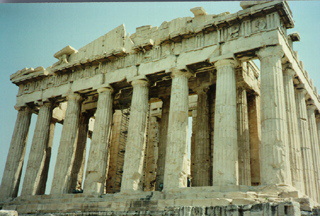Sparta vs Athens

Sparta V.S Athens
In the world of Ancient Greece there were many cities and governments, each with their own personal attributes. However, none were as powerful, or as noisy, as the rivals of Athens and Sparta. Their societies were very different, each had their own culture and their own policies. In this issue of my article series on Ancient Greece, I will be discussing their cultures and strong rivalry.
The Great Ancient City of Athens
Life in ancient Athens was more exciting than in most ancient cities, mainly due to the fact that Greeks had theater, great philosophers, were involved in politics, many were into athletics, and had developed the art of discourse at the Agora. The so-called Agora was the grand central market place, where many citizens gathered to discuss politics, socialize, and shop. The city was separated into districts with specific official locations around it. It was surrounded by an enormous wall that stretched circling the main city as well as stretching out towards the port of Athens. This wall was built during the Polynesian Wars with Sparta. Sparta’s warriors were too fierce to beat in the open field, so Athens built a wall and developed an enormous navy.
The extension of the Athenian wall allowed them security from the Spartans. Athenians had the ability to conduct trade and access to the Mediterranean Sea which was a big advantage. Since the Spartans had no strong navy, it wouldn’t be able to make a sufficient blockade to prevent people from leaving. The main or primary locations throughout Athens were the Pnyx, the Theatre of Dionysus, the Acropolis, the Agora, and multiple temples and locations placed in honor of the Olympians such as the Temple of Zeus, in the southeast corner of the city.
The Acropolis
A true marvel of the ancient world, the Acropolis of Athens, stands tall and beautiful over the city. It was the city’s citadel located on a rocky outcrop above the city of the Parthenon, the statue of Athena Promachos, and the theater of Dionysus. The Parthenon is one of the most famous ancient structures in the world, built in honor of the goddess Athena (goddess of war and wisdom). It was carved entirely from 21,650 tons of white marble and had a statue of Athena in the center of the main room made from gold and ivory. It was used as a temple where citizens could come pray and give offerings to the goddess, which were stored in a treasure room. The Parthenon today is still viewed as one of the greatest architectural marvels of the Ancient Greeks, along with the entire Acropolis.
The Acropolis of Athens was built in tribute to the goddess of Athena. According to legend, after the creation of the city, it was a dispute between the god of the ocean, Poseidon, and Athena on who it would be named after. Each presented the citizens of the city with a gift. Poseidon struck a rock with his trident and, as water gushed forth, he assured the people that now they would never suffer drought. Athena dropped a seed into the earth which sprouted swiftly as an olive tree, symbolizing peace and prosperity the people chose her as the patron of the city, and it was named after her. Although her statue in the Parthenon was massive, made of ivory, gold and worshiped, the statue had a big sister. The 100% bronze statue of Athena Promachos stood taller than the Parthenon at the gates to the Acropolis.
The Pnyx & Government
In Athens, there were two major foothills that stuck out of the ground. One was made into the Acropolis, the other became known as the Pnyx. The original government in Athens was an aristocracy meaning it was ruled by a privileged upper class, those that owned property and land. Then after a time of reform, it changed into a direct democracy in which the citizens of Athens had a direct say in the decisions made regarding the city. This is where the Pnyx comes in. It had a large open area with a long stage-like podium, this is where citizens of Athens, that either had influence or didn’t, came and spoke their mind. At the end of a meeting, a vote was conducted by a show of hands. The majority vote was the one that won.
Philosophy
Due to Athens becoming a direct democracy, it allowed for ideas to flourish and opinions to be heard. As a result, many great and famous philosophers came out of this important city- such as: Socrates, Aristotle, and Plato. As a matter of fact, they were the first to start properly questioning the world around us. They are known as the “Fathers of Philosophy” for a reason, and that reason is quite simple- they were the ones who created it. These great minds had a strong impact on Western History and the way we all think as humans. However, great philosophers weren’t the only thing that came out of Athens. Famous and great men such as Hippocrates (a revolutionary in medicine) or Pericles (who helped bring around the golden age of the city-state). I would even go as far as to argue that this was an Athenian Renaissance, similar to the Italian one that took place in the 16th,15th, and 14th centuries.
SPARTA The City of Soldiers
Sparta is one of the best-known city-states of Ancient Greece, but during the classical period, it was a very different place to Athens. Sparta was ruled by two kings and a Council of Elders. There was an assembly of citizens, but this did not have the power of the citizen assembly in democratic Athens. During the 5th century, B.C. Sparta was very powerful. This was due to her army, which was feared by all other Greek city-states. Sparta focused on producing good soldiers, and all Spartan male citizens were part of the army, they were bred for war.
The Spartan army played an important role in the Greek victory over the Persians, in 480-479 BC. Regarding this role today it is commonly referred to as the Battle of 300. It was a last stand of sorts in which the king of Sparta, at the time Leonidas, took 300 of the best Spartan warriors and met the Persians head-on in a narrow pass at Thermopylae. However, he was betrayed by a Greek who lead the Persians through a secret path through the mountains to outflank the 300. The battle was a loss, but it was a very big blow to the Persians. It was a battle in which a few stood against insurmountable odds and won, one of many throughout history.
The only thing a Spartan boy knew was that he must serve his country first, and put it before everything- even his own family. Boys in Sparta were introduced to battle, and to soldiers, early and were taught that to serve one’s country was their only goal in life. Women were treated very well in Spartan society. Unlike most women of Greece at the time, they were allowed a formal education which included lots of physical exercise. It was a common belief that if the woman was strong and athletic, she would produce stronger babies, who would later become strong soldiers. Their entire society was centered around war. When historians say bred for war, they mean it literally. If a child was deemed too weak to be a soldier, he was left atop a mountain to die, or on occasion, some parents might throw them off the mountain. These guys did not joke around.
It was not just a matter of the family, the city-state decided the fate of the child. Soldiers took the boys from their mothers at age 7, housed them in a dormitory with other boys, and trained them as soldiers. The mother’s softening influence was considered detrimental to a boy’s education. The boys endured harsh physical discipline and deprivation to make them strong. They marched without shoes and went without food. They learned to fight, endure pain, and survive through their wits.
Self-denial, simplicity, the warrior code, and loyalty to the city-state governed their lives. Spartan children were taught stories of courage and fortitude. One favorite story was about a boy who followed the Spartan code. He captured a live fox and intended to eat it. Although boys were encouraged to scrounge for food, they were punished if caught. The boy noticed some Spartan soldiers coming and hid the fox beneath his shirt. When the soldiers confronted him, he allowed the fox to chew into his stomach rather than confess and showed no sign of pain in his body or face. This was the Spartan way, intense right? Although this sort of raising and breeding was on another level it paid off the Spartan army was one of the most fierce in history to this day.
At the age of 20, or so, Spatans had to pass a rigorous test to graduate and become full citizens. Only the soldiers received aristocratic citizenship. If they failed their tests, they never became citizens but became perioeci, the middle class. Those that remained were allowed to live with their own families at age 30, and they continued to train and fight until the age of 60 when they retired. Even then, the soldier would still be in peak physical condition. Although the death rate at that time was quite small and many were lucky to even live to 60. Sparta’s entire society was based around warfare and nothing else. They were the perfect soldiers. They didn’t exactly do much else. All we know about Ancient Sparta was gathered from non-Spartan people that wrote about their experience visiting it. Spartans prohibited writing and literature, because they didn’t want anyone else to know what they were up to (or know any battle strategies they might use). The only known record of any other Spartan aspect of art or literature, are a number of ancient bronze pieces from the time before Sparta truly became a powerful city-state.
Although both of these civilizations, or city-states, were present thousands and thousands of years ago, it is important to look back on them so we can build off of it. Athens and Sparta are prime examples of societies that could be used to better our own. Perhaps even come up with a perfect, peaceful and prosperous society. We must look to the past to better our futures.










